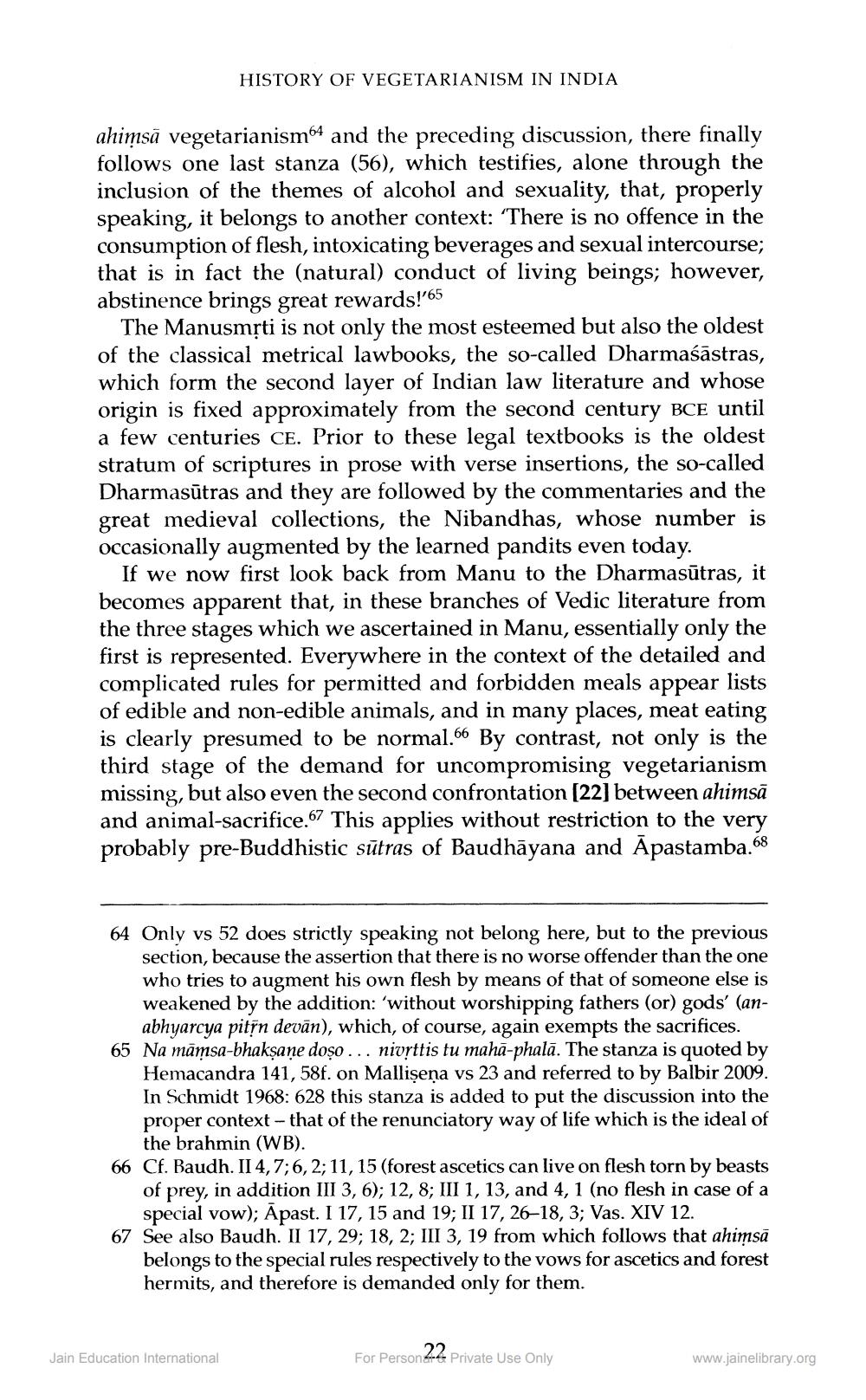________________
HISTORY OF VEGETARIANISM IN INDIA
ahimsā vegetarianism64 and the preceding discussion, there finally follows one last stanza (56), which testifies, alone through the inclusion of the themes of alcohol and sexuality, that, properly speaking, it belongs to another context: 'There is no offence in the consumption of flesh, intoxicating beverages and sexual intercourse; that is in fact the (natural) conduct of living beings; however, abstinence brings great rewards!'65
The Manusmộti is not only the most esteemed but also the oldest of the classical metrical lawbooks, the so-called Dharmaśāstras, which form the second layer of Indian law literature and whose origin is fixed approximately from the second century BCE until a few centuries CE. Prior to these legal textbooks is the oldest stratum of scriptures in prose with verse insertions, the so-called Dharmasūtras and they are followed by the commentaries and the great medieval collections, the Nibandhas, whose number is occasionally augmented by the learned pandits even today.
If we now first look back from Manu to the Dharmasūtras, it becomes apparent that, in these branches of Vedic literature from the three stages which we ascertained in Manu, essentially only the first is represented. Everywhere in the context of the detailed and complicated rules for permitted and forbidden meals appear lists of edible and non-edible animals, and in many places, meat eating is clearly presumed to be normal.66 By contrast, not only is the third stage of the demand for uncompromising vegetarianism missing, but also even the second confrontation [22] between ahimsā and animal-sacrifice.67 This applies without restriction to the very probably pre-Buddhistic sūtras of Baudhāyana and Āpastamba.68
64 Only vs 52 does strictly speaking not belong here, but to the previous
section, because the assertion that there is no worse offender than the one who tries to augment his own flesh by means of that of someone else is weakened by the addition: 'without worshipping fathers (or) gods' (an
abhyarcya pitsn devān), which, of course, again exempts the sacrifices. 65 Na māmsa-bhaksane doso... nivrttis tu maha-phalā. The stanza is quoted by
Hemacandra 141,58f. on Mallişeņa vs 23 and referred to by Balbir 2009. In Schmidt 1968: 628 this stanza is added to put the discussion into the proper context - that of the renunciatory way of life which is the ideal of
the brahmin (WB). 66 Cf. Baudh. II 4,7;6, 2; 11, 15 (forest ascetics can live on flesh torn by beasts
of prey, in addition III 3, 6); 12, 8; III 1, 13, and 4, 1 (no flesh in case of a
special vow); Apast. I 17, 15 and 19; II 17, 26–18, 3; Vas. XIV 12. 67 See also Baudh. II 17, 29; 18, 2; III 3, 19 from which follows that ahimsā
belongs to the special rules respectively to the vows for ascetics and forest hermits, and therefore is demanded only for them.
Jain Education International
For Person 22 Private Use Only
www.jainelibrary.org




